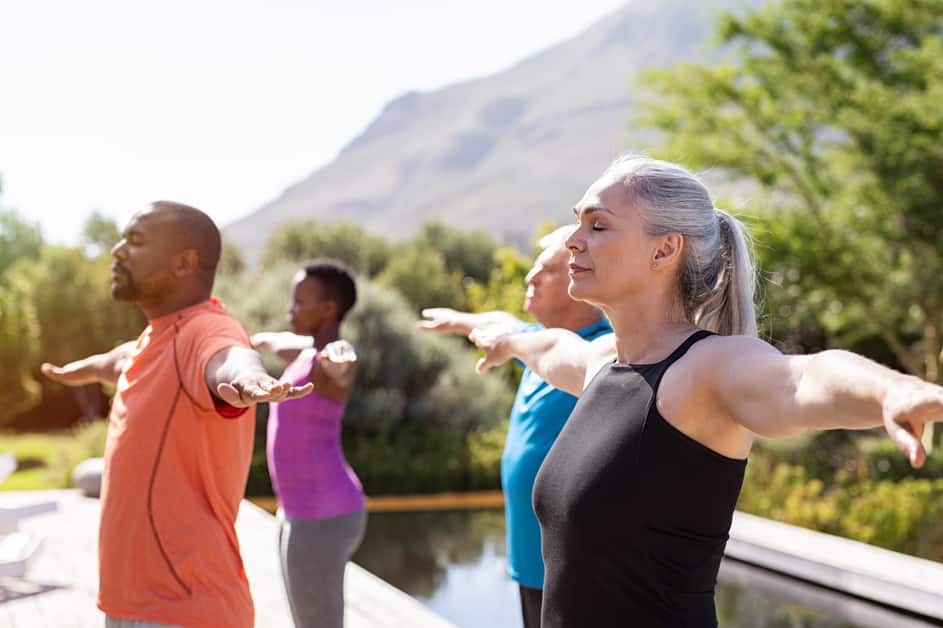Introduction
Knee pain caused by overuse is a common issue. It can stop us from doing the things we want to do, and cause us a lot of distress. Mind-body techniques can help us to relieve this pain. They take account of our physical, emotional and mental states, instead of just focusing on the physical structure or tissue condition.
In this guide, we’ll talk about some of the mind-body techniques that can help you to deal with overuse knee pain. We’ll explain how they work, and the advantages of using them. We’ll also tell you how to get started with them if you’re interested. Finally, we’ll give you some tips on how to make the most of these methods.
Mind-Body Techniques to Manage Overuse Knee Pain
Managing knee pain can be tough, especially when it’s from an overuse injury. But, you can use mind-body techniques to help control the pain and overcome it without medication. Here are a few strategies, such as visualization, deep breathing, and progressive relaxation. Give them a try!
Deep Breathing
Deep breathing exercises can be great for managing knee pain. They give the body and mind relaxation, oxygen and can help with physical pain. It’s known to reduce muscle tension and stress.
It’s best to do this exercise regularly for the best results. Find a comfy position and slowly breathe in for 6 seconds, counting 1-2-3-4-5-6. Imagine the breath going down into your belly. Exhale for 7 seconds, counting 1-2-3-4-5-6-7 as you exhale out of the mouth. This helps activate the parasympathetic nervous system which relaxes you and decreases inflammation.
Start by doing this 10 times, then gradually increase until you reach 20 rounds. Try it while lying or sitting in a peaceful environment like your living room or bedroom. Visualize yourself in a calming place or walking through a garden of colors.
Deep breathing can help address chronic pain naturally and effectively.
Visualization
Visualization is a way to manage chronic pain with your mind and body. Create images of your body calming down, the pain subsiding and healing of the tissue. Visualization has been found to be helpful in reducing stress and improving relaxation.
To begin, find a relaxing position and close your eyes. Imagine a safe place, real or spiritual. Picture how it feels when your knee is not in pain. What color would it be? How does it move? Would you feel stronger or lighter? Then focus on the feelings with no knee pain – relieved or grateful?
Breathe deeply and slowly while sending positive energy to your knee. Envision changes like temperature or lightness in the area. Stay with this visualization for a few minutes then open your eyes. You may notice a decrease in the physical discomfort and heightened emotions.
Repeat these techniques regularly until you get the desired results of managing overuse knee pain naturally with visualization!
Guided Imagery
Guided imagery is a holistic therapy to manage knee pain. It uses your imagination. A mental health professional or another person can guide you through this. They use words to help you relax, be in the present moment and feel peaceful, safe, and in control. Imagine being in a calm beach or forest with people who care about you.
Guided imagery helps ease physical tension in your knee area and reduce stress. When practiced with other mind-body therapies like yoga or Tai Chi, it can help with pain from overuse.
Progressive Muscle Relaxation
Doing progressive muscle relaxation helps to cut down physical tension in the body and can help heal overuse knee pain. It has two steps – tensing and releasing.
- Tensing: Start with the feet. Slowly tense your muscle groups around the area of injury while breathing in deeply. Hold on for 10-20 seconds, then release while breathing out. Do this for each muscle group, up to the neck.
- Releasing: After tensing, let each part of your body relax and lengthen while focusing on deep breathing. Make sure each muscle is released before going to another area. Spend the same amount of time releasing as was spent tensing. When done, note any areas that feel tight or need more attention – especially near the injury.
Regularly doing progressive muscle relaxation can help reduce stress and heal overuse knee pain caused by physical exertion or mental strain. If done often with other mind-body techniques like yoga or meditation, it can be an effective way to manage pain naturally and may lead to lasting improvements in life.
Mindfulness Meditation
Mindfulness meditation was created in the 1970s by Jon Kabat-Zinn. It helps us focus on the present moment, without judging ourselves or our thoughts. This can help reduce pain and stress related to overuse knee injury.
Mindfulness also increases flexibility, both physically and mentally. It helps us understand our body’s response to different situations. This can help avoid chronic long-term knee pain and dysfunction associated with overuse injuries.
With regular mindfulness practice, we can better manage our thoughts and emotions. This allows us to let go of painful feelings like frustration and worry. Taking a few moments each day for mindfulness can help reduce pain and stress.
How to Incorporate Mind-Body Techniques into Your Daily Routine
Mind-body techniques are a great way to reduce and manage pain without invasive treatments or drugs. Incorporate them into your routine and you can lessen the intensity and length of your pain. They can also help with focus, relaxation, reducing stress and anxiety, and feeling better.
In this article, we’ll talk about how to use mind-body techniques to manage and decrease overuse knee pain.
Establishing a Regular Routine
Establishing a regular routine is essential for effective mind-body techniques. This should include calming activities, like yoga, meditation, or Pilates. Relaxing helps your body reduce stress, which is important for reducing overuse knee pain.
Take 20 minutes each day to relax. Try mindfulness-based stress reduction (MBSR), diaphragmatic breathing, progressive muscle relaxation, and observe how your body responds.
Regular meditation creates a connection between your mind and body. It also helps with physical fitness, behavioral changes, and self reflection. This reduces knee pain from overuse injuries.
In addition to meditation, do hip openers like Pigeon Pose or Eagle Pose. These reduce tension in the hips and give a greater range of motion, so knee pain decreases.
Physical therapy can help customize an approach to a specific situation. This takes into account all variables, avoiding impulsive tendencies and unifying all forces to reach a positive patient outcome.
Making Time for Mind-Body Exercises
Finding the time for mind-body exercise can be a challenge. We have so many duties at work and home. But, if you want to feel healthier and reduce pain, it’s worth it. You only need 15-20 minutes per day. Here are some tips to get started:
- Set aside a short time for yourself;
- Start the day with movements or stretching;
- Schedule 10 minutes each morning or evening;
- Create a calming atmosphere;
- Listen to a Youtube meditation/yoga session;
- Pick one type of exercise to make it a ritual;
- Attend virtual classes with experts.
Benefits of Mind-Body Techniques
Mind-body techniques, such as meditation, yoga, and tai chi, can make a great difference to chronic pain issues – especially regarding overuse knee pain. Studies have proven that these strategies can lessen stress while boosting the body’s capacity to manage and control pain.
In this article, let’s explore the advantages of utilizing mind-body techniques to naturally reduce or remove knee pain.
Improved Mood and Stress Levels
Yoga, meditation and tai chi can help reduce stress levels. They teach us mindful breathing, proper posture and attitude. This can relieve the pain associated with chronic pain. Studies show regular practice of these techniques reduces cortisol and improves health.
Mood improvements can also raise our pain threshold. This helps us cope with overuse knee pain. The techniques also release tension from around the knee joint. This increases flexibility, leading to a higher range of motion.
Reduced Pain and Inflammation
Mind-body techniques can reduce pain and inflammation from overworking your knee joint or damages to cartilage. Exercises like yoga and tai chi create a connection between thoughts and physical feelings. Even though this won’t heal the injury, it can reduce tension that the pain causes. Mindful breath and movements can also restore coordination and reduce pain from overused muscles.
Endorphins are natural anti-inflammatory chemicals. They can reduce symptoms of diseases like arthritis and tendonitis. These hormones also keep cortisol levels low, which can calm people throughout the day. Because of the relaxation response yoga creates, many people can move their joints better, which is helpful for those struggling with range of motion due to injury or disease.
Increased Mobility and Flexibility
Mind-body techniques can help relieve overuse knee pain. Yoga, tai chi and qigong are used to increase mobility and flexibility. Practicing these exercises can make the affected joint more flexible. Also, these exercises balance the muscle groups around the joint. This can improve posture and make it easier to move. Thus, improved flexibility can ease chronic pain and help you use your body more effectively.
Conclusion
This guide combines mind-body approaches to naturally manage and even eliminate overuse knee pain. We can become aware of our body and the feelings we experience during movement or throughout the day. This helps us to understand how to care for our body. We can also use different breathing techniques to ease muscle tension and reduce stiffness.
Remaining dedicated to the practice is important. Patience, consistency and practice are key. We must also be mindful of our physical limits to prevent injury or further deviation from optimal health.
With time, we will gain trust in the healing power of our own body. This will give us control over this difficulty.
Frequently Asked Questions
Q1: What are mind-body techniques for overcoming overuse knee pain?
A1: Mind-body techniques are relaxation practices, such as meditation, yoga, and biofeedback, that can help to reduce overuse knee pain. These techniques can help to relax tense muscles, release stress, and promote healing in the body.
Q2: What are the benefits of using mind-body techniques for overuse knee pain?
A2: Mind-body techniques can help to reduce pain, improve range of motion, and increase flexibility in the knee joint. They can also help to reduce the risk of further injury and improve overall wellbeing.
Q3: How often should I practice mind-body techniques for overuse knee pain?
A3: It is recommended that you practice mind-body techniques for overuse knee pain several times per week. You should also focus on stretching and strengthening exercises for the affected area to promote healing.





